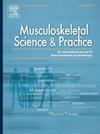评估持续性脊柱疼痛患者简短疼痛量表的最小重要变化
IF 2.2
3区 医学
Q1 REHABILITATION
引用次数: 0
摘要
简要疼痛量表(BPI)是一种广泛使用的评估疼痛严重程度和干扰的工具,与生物-心理-社会模型相一致。它已在多种语言中用于治疗持续性脊柱疼痛的患者。然而,最小重要变化(MIC),即患者认为有意义的最小变化,尚未对这一患者群体进行探索。目的本研究旨在评估持续性脊柱疼痛患者BPI-DK的MIC。方法采用基于锚点的方法和基于分布的方法估计smic。采用锚定法计算GROC量表改善患者的BPI-DK亚量表的平均变化。基于分布的方法估计MIC为测量标准误差的1.96倍。结果共有135例患者完成了基线和3个月随访问卷。所有子量表的MIC得分均有统计学意义。根据使用的方法,严重干扰的MIC范围为1.37至2.61,物理干扰为1.59至2.91,情感干扰为1.08至3.11,总体干扰为1.38至2.72。结论本研究建立了持续性脊柱疼痛患者BPI-DK的MIC。基于锚点的方法和基于分布的方法之间的差异突出了该方法的敏感性,基于分布的估计表明了测量不确定性之外的变化。对于这一人群,2点的改善是有临床意义的。本文章由计算机程序翻译,如有差异,请以英文原文为准。
Estimation of the minimal important change for Brief Pain Inventory in patients with persistent spinal pain
Background
The Brief Pain Inventory (BPI) is a widely used tool for assessing pain severity and interference, aligning with the bio-psycho-social model. It has been validated in various languages for patients with persistent spinal pain. However, the Minimal Important Change (MIC), which represents the smallest change perceived as meaningful by patients, has not yet been explored for this patient population.
Objective
This study aimed to estimate the MIC for the BPI-DK in patients with persistent spinal pain.
Methods
MIC was estimated using both anchor-based and distribution-based approaches. The anchor-based method was used to calculate mean changes in BPI-DK subscales for patients reporting improvement on the GROC scale. The distribution-based method estimated MIC as 1.96 times the standard error of measurement.
Results
A total of 135 patients completed both baseline and 3-month follow-up questionnaires. Statistically significant MIC scores were found across all subscales. The MIC ranged from 1.37 to 2.61 for severity subscore, 1.59 to 2.91 for physical interference, 1.08 to 3.11 for affective interference, and 1.38 to 2.72 for overall interference subscore, depending on the method used.
Conclusion
This study establishes the MIC for the BPI-DK in patients with persistent spinal pain. Differences between the anchor-based and distribution-based methods highlight the sensitivity of the approach, with distribution-based estimates suggesting changes beyond measurement uncertainty. A 2-point improvement is recommended as clinically meaningful for this population.
求助全文
通过发布文献求助,成功后即可免费获取论文全文。
去求助
来源期刊

Musculoskeletal Science and Practice
Health Professions-Physical Therapy, Sports Therapy and Rehabilitation
CiteScore
4.10
自引率
8.70%
发文量
152
审稿时长
48 days
期刊介绍:
Musculoskeletal Science & Practice, international journal of musculoskeletal physiotherapy, is a peer-reviewed international journal (previously Manual Therapy), publishing high quality original research, review and Masterclass articles that contribute to improving the clinical understanding of appropriate care processes for musculoskeletal disorders. The journal publishes articles that influence or add to the body of evidence on diagnostic and therapeutic processes, patient centered care, guidelines for musculoskeletal therapeutics and theoretical models that support developments in assessment, diagnosis, clinical reasoning and interventions.
 求助内容:
求助内容: 应助结果提醒方式:
应助结果提醒方式:


